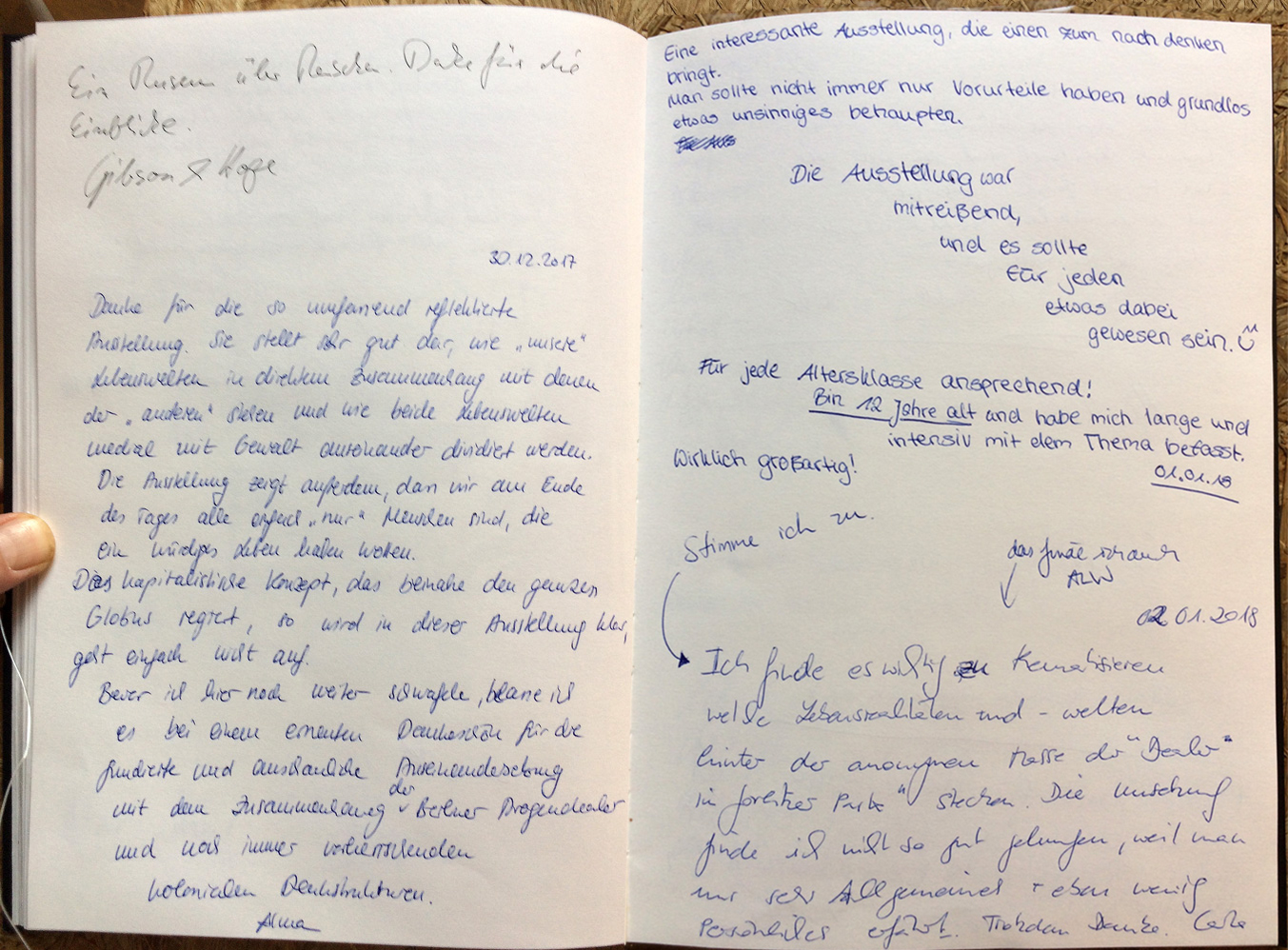
Exhibition views
Scott-Holmquist-Studio.jpg)
As visitors enter the exhibit, they see twelve hulking and blank, human-shaped cardboard silhouettes, some grouped, some standing alone, all at varying angles. Once past the first figure, visitors discover on the reverse side depictions of the dealer’s place of origin and migration route. Along one wall, printed materials from periodicals are arranged on desk-like displays and easels and cross the room is the Travel Portal.
From overhead, visitors hear altered ambient outdoor sounds of the places described on the figures, urban and rural, produced for the exhibition by Tom Ritchford, musician sound artist.
Scott-Holmquist-Studio.jpg)
Twelve cardboard figures, all slightly larger than life-sized, are bolted to thick cardboard stands and arrayed from near the entry to the back of the space. The front is blank. On the back (the surface facing away from the entrance), each figure displays photographs from the place of origin of one dealer, a text with information about this place (printed in the dealer's native language), and the dealer's migration route, a hand-drawn map with an unfamiliar West-East orientation. At the base of each figure, there is a tablet of sheets with the African-language texts translated into German and English.
Scott-Holmquist-Studio.jpg)
Scott-Holmquist-Studio.jpg)
Scott-Holmquist-Studio.jpg)
Scott-Holmquist-Studio.jpg)
Scott-Holmquist-Studio.jpg)
The media swallowed the exhibit itself when, on the day it opened, Berlin's largest daily, the tabloid B.Z., inserted a stock photograph of black park dealers, already used by several other outlets to illustrate the exhibit, into a photograph depicting a model of the exhibit that was part of an early press release for the show. This new collage by B.Z. was then integrated by the artist into a collage in the exhibit, previously named "AfD Poster," because of the use of the stock dealer photograph in a poster campaign for the extreme right party, Alternative für Deutschland (Alternative for Germany), that promised rapid expulsion of immigrants like those depicted in the stock image.
You can see and download larger image of the exhibition version of "Stock Dealers" collage here.
Scott-Holmquist-Studio.jpg)
An active media collection included desk-height displays and tableaus on cardboard easels presenting selections from more than 500 articles on public drug dealing in Germany. The entire collection is assembled in binders on a reading table at the back of the space, along with related academic articles and books.
The collection was updated bi-weekly and included more than 90 articles about the exhibit itself.
Scott-Holmquist-Studio.jpg)
Scott-Holmquist-Studio.jpg)
Scott-Holmquist-Studio.jpg)
Scott-Holmquist-Studio.jpg)
Scott-Holmquist-Studio.jpg)
Right from the entrance is a steel figure, its shape identical to
those of cardboard except for the vitrine on its chest containing
images, a text and a map (like the reverse sides of the other
figures).
Beside the steel figure is a large wall-mounted architectural plan
of mechanical renderings, elevations and aerial photographs that
depict the placement of figures like those in the exhibit in two
Berlin parks, Viktoria and Görlitzer.
Scott-Holmquist-Studio.jpg)
Scott-Holmquist-Studio.jpg)
Scott-Holmquist-Studio.jpg)
The Travel Portal is a workstation composed of a desk, stools
and computers. It is dominated by a large centerpiece travel map
tipping North to East, with West Africa prominently featured at
the top and center and Europe at the far right. Swooping red
lines mark flight routes from Berlin to each of the subject dealers’
place of origin. Computer terminals list travel options and links to
airlines, hotels and restaurants for each location.
The Travel Portal was also online for the duration of the exhibit.
Scott-Holmquist-Studio.jpg)
Scott-Holmquist-Studio.png)

All images © Scott Holmquist 2017
Photos by Hans-Georg Gaul
Scott Holmquist Studio
info@scottholmquist.com
Downloads
Pressemitteilung – Deutsch
Press Release – English
© 2018 Scott Holmquist



